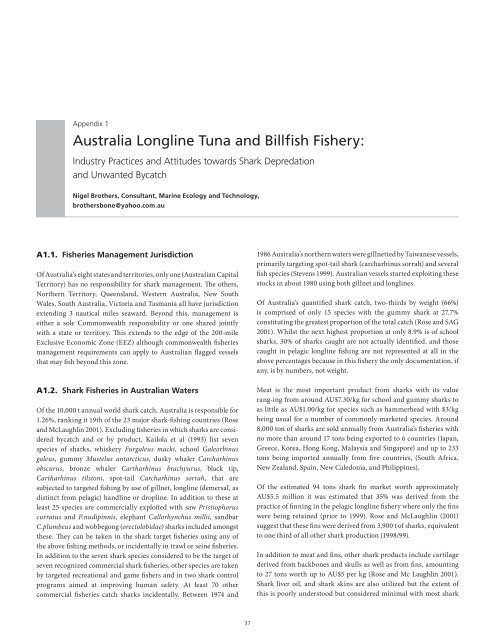Shark Depredation and Unwanted Bycatch in Pelagic Longline
Shark Depredation and Unwanted Bycatch in Pelagic Longline
Shark Depredation and Unwanted Bycatch in Pelagic Longline
Create successful ePaper yourself
Turn your PDF publications into a flip-book with our unique Google optimized e-Paper software.
Appendix 1<br />
Australia Longl<strong>in</strong>e Tuna <strong>and</strong> Billfish Fishery:<br />
Industry Practices <strong>and</strong> Attitudes towards <strong>Shark</strong> <strong>Depredation</strong><br />
<strong>and</strong> <strong>Unwanted</strong> <strong>Bycatch</strong><br />
Nigel Brothers, Consultant, Mar<strong>in</strong>e Ecology <strong>and</strong> Technology,<br />
brothersbone@yahoo.com.au<br />
A1.1. Fisheries Management Jurisdiction<br />
Of Australia’s eight states <strong>and</strong> territories, only one (Australian Capital<br />
Territory) has no responsibility for shark management. The others,<br />
Northern Territory, Queensl<strong>and</strong>, Western Australia, New South<br />
Wales, South Australia, Victoria <strong>and</strong> Tasmania all have jurisdiction<br />
extend<strong>in</strong>g 3 nautical miles seaward. Beyond this, management is<br />
either a sole Commonwealth responsibility or one shared jo<strong>in</strong>tly<br />
with a state or territory. This extends to the edge of the 200-mile<br />
Exclusive Economic Zone (EEZ) although commonwealth fisheries<br />
management requirements can apply to Australian flagged vessels<br />
that may fish beyond this zone.<br />
A1.2. <strong>Shark</strong> Fisheries <strong>in</strong> Australian Waters<br />
Of the 10,000 t annual world shark catch, Australia is responsible for<br />
1.26%, rank<strong>in</strong>g it 19th of the 23 major shark-fish<strong>in</strong>g countries (Rose<br />
<strong>and</strong> McLaughl<strong>in</strong> 2001). Exclud<strong>in</strong>g fisheries <strong>in</strong> which sharks are considered<br />
bycatch <strong>and</strong> or by product, Kailola et al (1993) list seven<br />
species of sharks, whiskery Furgaleus macki, school Galeorb<strong>in</strong>us<br />
galeus, gummy Mustelus antarcticus, dusky whaler Carcharh<strong>in</strong>us<br />
obscurus, bronze whaler Cartharh<strong>in</strong>us brachyurus, black tip,<br />
Cartharh<strong>in</strong>us tilstoni, spot-tail Carcharh<strong>in</strong>us sorrah, that are<br />
subjected to targeted fish<strong>in</strong>g by use of gillnet, longl<strong>in</strong>e (demersal, as<br />
dist<strong>in</strong>ct from pelagic) h<strong>and</strong>l<strong>in</strong>e or dropl<strong>in</strong>e. In addition to these at<br />
least 25 species are commercially exploited with saw Pristiophorus<br />
curratus <strong>and</strong> P.nudip<strong>in</strong>nis, elephant Callorhynchus millii, s<strong>and</strong>bar<br />
C.plumbeus <strong>and</strong> wobbegong (orectolobidae) sharks <strong>in</strong>cluded amongst<br />
these. They can be taken <strong>in</strong> the shark target fisheries us<strong>in</strong>g any of<br />
the above fish<strong>in</strong>g methods, or <strong>in</strong>cidentally <strong>in</strong> trawl or se<strong>in</strong>e fisheries.<br />
In addition to the seven shark species considered to be the target of<br />
seven recognized commercial shark fisheries, other species are taken<br />
by targeted recreational <strong>and</strong> game fishers <strong>and</strong> <strong>in</strong> two shark control<br />
programs aimed at improv<strong>in</strong>g human safety. At least 70 other<br />
commercial fisheries catch sharks <strong>in</strong>cidentally. Between 1974 <strong>and</strong><br />
1986 Australia’s northern waters were gillnetted by Taiwanese vessels,<br />
primarily target<strong>in</strong>g spot-tail shark (carcharh<strong>in</strong>us sorrah) <strong>and</strong> several<br />
fish species (Stevens 1999). Australian vessels started exploit<strong>in</strong>g these<br />
stocks <strong>in</strong> about 1980 us<strong>in</strong>g both gillnet <strong>and</strong> longl<strong>in</strong>es.<br />
Of Australia’s quantified shark catch, two-thirds by weight (66%)<br />
is comprised of only 15 species with the gummy shark at 27.7%<br />
constitut<strong>in</strong>g the greatest proportion of the total catch (Rose <strong>and</strong> SAG<br />
2001). Whilst the next highest proportion at only 8.9% is of school<br />
sharks, 30% of sharks caught are not actually identified, <strong>and</strong> those<br />
caught <strong>in</strong> pelagic longl<strong>in</strong>e fish<strong>in</strong>g are not represented at all <strong>in</strong> the<br />
above percentages because <strong>in</strong> this fishery the only documentation, if<br />
any, is by numbers, not weight.<br />
Meat is the most important product from sharks with its value<br />
rang-<strong>in</strong>g from around AU$7.30/kg for school <strong>and</strong> gummy sharks to<br />
as little as AU$1.00/kg for species such as hammerhead with $3/kg<br />
be<strong>in</strong>g usual for a number of commonly marketed species. Around<br />
8,000 ton of sharks are sold annually from Australia’s fisheries with<br />
no more than around 17 tons be<strong>in</strong>g exported to 6 countries (Japan,<br />
Greece, Korea, Hong Kong, Malaysia <strong>and</strong> S<strong>in</strong>gapore) <strong>and</strong> up to 233<br />
tons be<strong>in</strong>g imported annually from five countries, (South Africa,<br />
New Zeal<strong>and</strong>, Spa<strong>in</strong>, New Caledonia, <strong>and</strong> Philipp<strong>in</strong>es).<br />
Of the estimated 94 tons shark f<strong>in</strong> market worth approximately<br />
AU$5.5 million it was estimated that 35% was derived from the<br />
practice of f<strong>in</strong>n<strong>in</strong>g <strong>in</strong> the pelagic longl<strong>in</strong>e fishery where only the f<strong>in</strong>s<br />
were be<strong>in</strong>g reta<strong>in</strong>ed (prior to 1999). Rose <strong>and</strong> McLaughl<strong>in</strong> (2001)<br />
suggest that these f<strong>in</strong>s were derived from 3,900 t of sharks, equivalent<br />
to one third of all other shark production (1998/99).<br />
In addition to meat <strong>and</strong> f<strong>in</strong>s, other shark products <strong>in</strong>clude cartilage<br />
derived from backbones <strong>and</strong> skulls as well as from f<strong>in</strong>s, amount<strong>in</strong>g<br />
to 27 tons worth up to AU$5 per kg (Rose <strong>and</strong> Mc Laughl<strong>in</strong> 2001).<br />
<strong>Shark</strong> liver oil, <strong>and</strong> shark sk<strong>in</strong>s are also utilized but the extent of<br />
this is poorly understood but considered m<strong>in</strong>imal with most shark<br />
37












